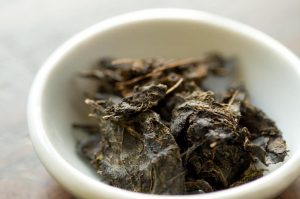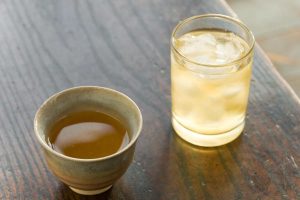
Thanks to my friend Noli from Sugimoto America, I had the chance to try this rare type of Japanese dark tea.
He gave me this and other tea samples from his recent business trip to Japan.
Kurocha (黒茶) is the word for dark tea, and Ishizuchi (石鎚, stone hammer) refers to Mount Ishizuchi in Ehime prefecture.
This tea comes from Komatsu town, at the hillside of Mount Ishizushi, with an altitude of 600 meters (1968 feet) above sea level.
Although it has a long history, the production has decreased to a point where now only a few people know how to make it.
How is Ishizuchi kurocha made?
Just like goishicha, this tea has a two-step fermentation process. As far as I know, this type of dark tea processing is only found in Japan.
It’s done once a year in the middle of summer.
First, mature tea branches are harvested and steamed in a barrel. The leaves naturally fall off the branches after steaming.
The next step is fermentation with mold belonging to the Aspergillus genus. This step takes about a week.
Apparently, the process doesn’t go well if done outside Mount Ishizuchi because there’s a higher chance that other types of mold appear.
Once fermented, the tea leaves are rolled. I guess that they are rolled mildly, because the finished product doesn’t look like rolled leaves.
Then the leaves go through anaerobic fermentation with lactic acid bacteria for two to three weeks.
Finally, the leaves are dried under the sun for two or three days.
More about Ishizuchi kurocha
Like goishicha, this tea is low on catechins and L-theanine, but relatively high in GABA.
Both are marketed as healthy teas because GABA helps with reducing blood pressure. This aspect is what saved both teas, since otherwise there wouldn’t be much demand for them.
This tea’s annual production is much less than goishicha, and thus it’s very hard to obtain. Right now it can’t be bought outside Japan, not even from online tea stores.

The way to prepare it is simple: use 2 to 3 grams of ishizuchi kurocha and infuse in 360 ml (12 oz) of boiling water for 1 to 2 minutes.
It tastes good when cold, because its acidity lowers.
Additionally, it can be used as a cooking ingredient, which was the original purpose of this dark tea.
To find out what it tastes like, read my next tea review.





January 1, 2017
Okay, where should I look to get both the kurochas. You have my curiosity.
January 2, 2017
Hi Geoff
Outside Japan it’s not available, at least from what I searched online.
Your best bet would be to contact Noli Ergas.